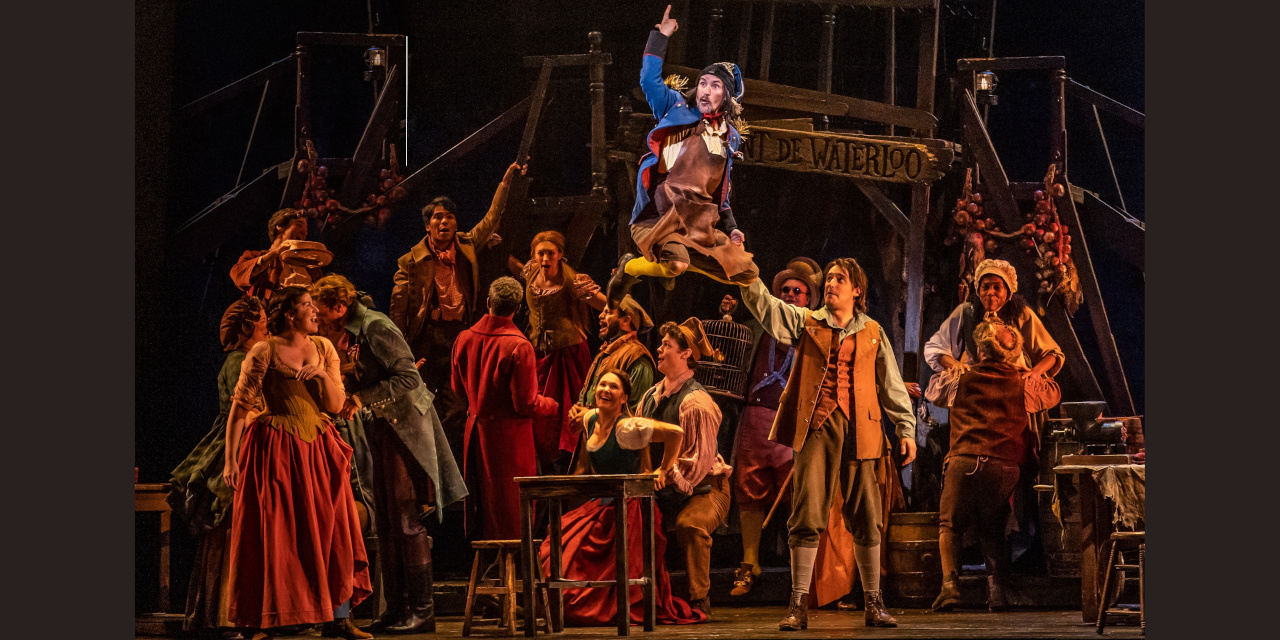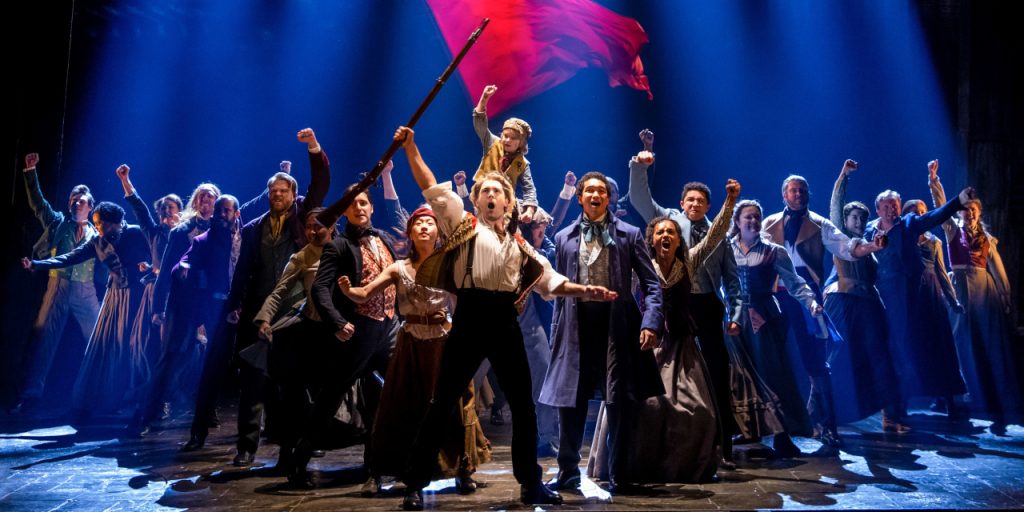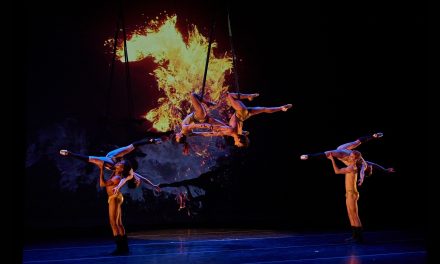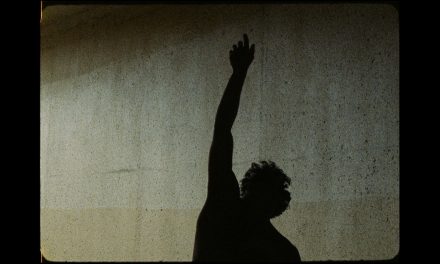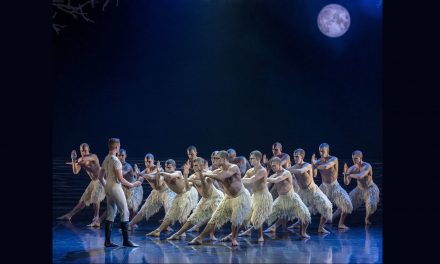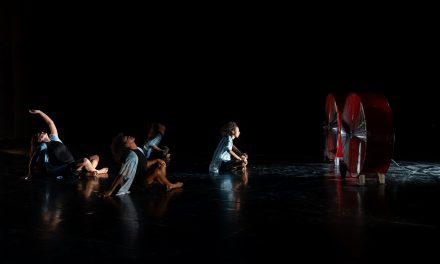Les Misérables is a musical version of Victor Hugo’s 1862 novel about one of the many rebellions in Paris, France, after the Revolution of 1789. It has music by Claude-Michel Schönberg, lyrics by Alain Boublil and Jean-Marc Natel, and a libretto by Schönberg and Boublil. It originally premiered in Paris in 1980 with direction by Robert Hassein. An adaptation by producer Cameron Mackintosh with lyrics by Herbert Kretzmer has been running in London since October 1985, making it the longest-running musical in West End and the longest-running musical in the world after The Fantasticks.
From the opening scene of prisoners on a ship, it is apparent that this musical not only packs a punch visually, but also aurally as well. The voices are rich in timbre and depth, the actors committed. It doesn’t matter if you have seen it before or know the lyrics forward and backwards, it is at the core a story about people, humans like you and me caught up in events that both define them and limit them. It is also a cautionary tale against the baser human behaviors. Greed, pride, guilt, calumny, jealousy, lies, envy, and hatred are all on display in the various characters; although some find redemption in noble deaths and good deeds as they struggle with their circumstances.
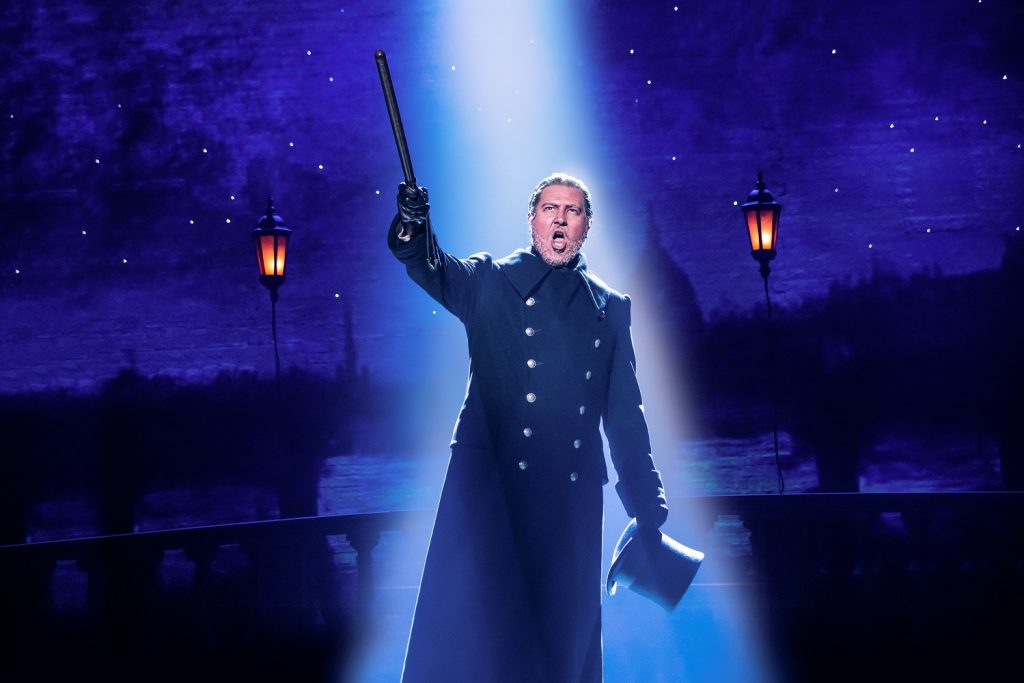
Preston Truman Boyd as Javert in Les Misérables – Photo by Matthew Murphy & Evan Zimmerman for MurphyMade
We meet Jean Valjean (Nick Cartell) upon his release from prison where he has spent the last 19 years of his life for stealing a loaf of bread (5 for the bread and the rest for escape attempts). Mr. Cartell was entirely up to the task of delivering the pathos of Jean Valjean and his never-ending struggle with morality and guilt. His voice is incredible and hit every nuance of character available to the role.
He was amply met at every turn by Javert (Preston Truman Boyd) who released him from prison and then was able to track and chase Valjean throughout the years as a Paris Inspector. Boyd’s voice was the embodiment of Javert who transmits self-righteous judgment but then has a life-changing revelation late in the game of cat and mouse. He is self-assured, correct, on the side of the law with no room for any grey area. They are both the foundation and launching point of the whole show and they hold it beautifully.
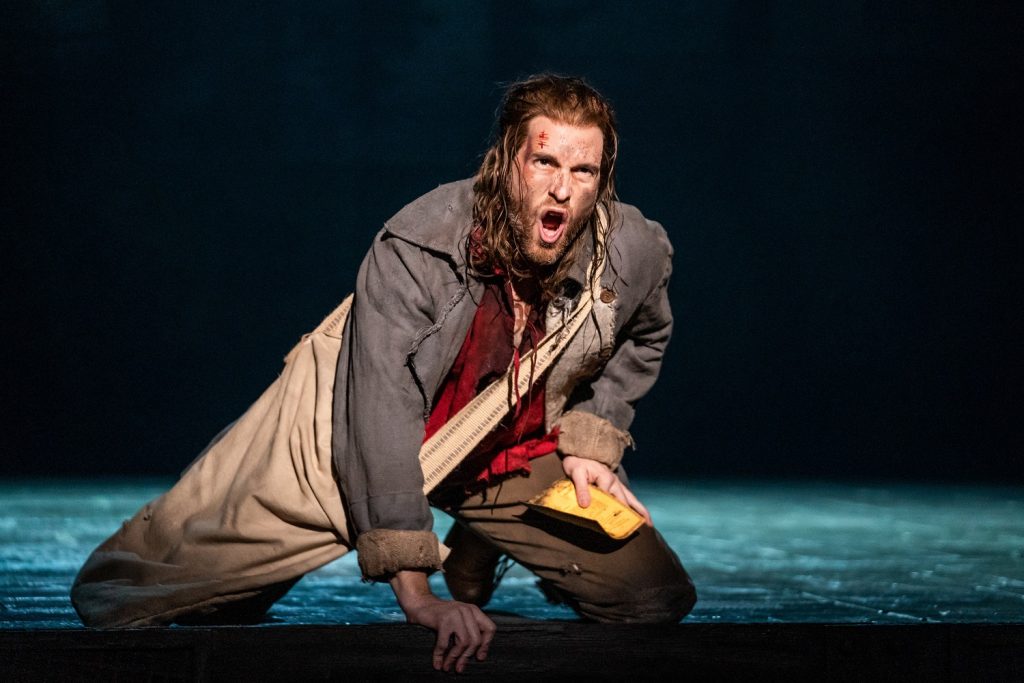
Nick Cartell as Jean Valjean in “Les Misérables” – Photo by Matthew Murphy & Evan Zimmerman for MurphyMade
Fantine, played by Haley Dortch was effective vocally, as was Christine Heesun Hwang as Éponine. Both have fantastic range and control of their voices. However, some of the power of their performance was lessened by their acting direction which allowed them to take emotional liberties with their material. Sometimes emoting to the degree that sacrifices aspects of the notes and lyrics hurts rather than helps the portrayal of the character.
The Thénardiers (Matt Crowle, Christina Rose Hall) were aptly comedic delivering their over-the-top performances depicting the more opportune of Parisians. First in their number, ‘Master of the House’ and then ‘Beggars at the Feast’ we are treated to their greedy shenanigans and desperate attempts to force their way in to the ‘upper crust’ of society. Their performance would not be so funny if it were not so true especially here in Hollywood where we are met with daily examples.
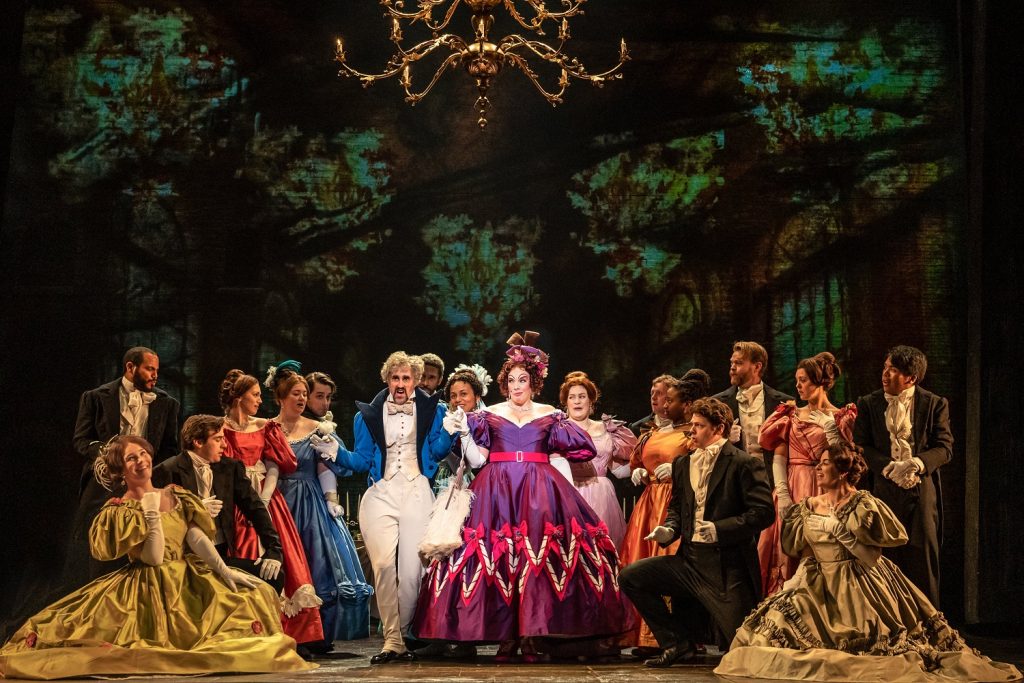
“Beggars at the Feast” from “Les Misérables” – Photo by Matthew Murphy & Evan Zimmerman for MurphyMade
Lighting by Paule Constable was gorgeous and dramatic and helped tell the story and cue what was happening in any given scene. Many scenes were darkly lit matching the mood of the piece, but every detail was observable and taken in. Especially effective was the death spot on certain characters as their souls are lifted to Heaven.
Original Costume designs by Andreane Neofitou and additional designs by Christine Rowland and Paul Wills were lovely where that was called for and grotesque where that was needed. The rags of beggars and the poor in the streets were underdressed with the workers’ uniforms in the factory making a brilliant fast change into that scene. The street walkers’ costumes were a kaleidoscope of color and betrayed the dark humor of their profession. Throughout the show there were splashes of red which always kept in mind the blood that would run and the sacrifice made for their cause.
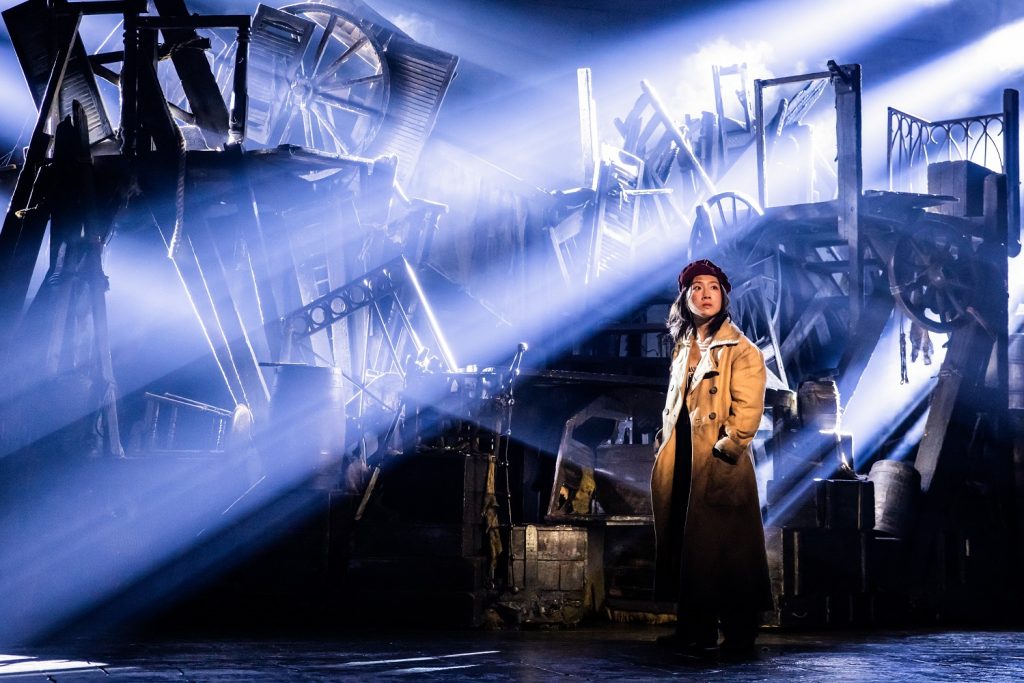
Christine Heesun Hwang as Éponine in “Les Misérables” – Photo by Matthew Murphy & Evan Zimmerman for MurphyMade
There were also projections by Finn Ross and Fifty-Nine Productions. These were mostly backgrounds that moved slightly in order to give the appearance of the characters moving through the city. Although they were well-thought out, they were entirely unnecessary. We know that Valjean is carrying Marius through the sewers of Paris, we don’t need to see an interactive background of them as if on a ride at Universal Studios. Again, the focus is on the characters, not whatever modern wizardry can ‘transport’ us to Paris of 1832. The singing and acting are supposed to do that.
The set changes were incredibly smooth and the crew for this show should get a bow. The ship disappears into the smoke and the next scene miraculously materializes into view. There is no turntable for this show, but the use of the side wings augments the changes of scene very well. Set design was by Matt Kinley. The barricade takes up the entirety of the proscenium and is monolithic in its’ presence helping the audience to comprehend that lives will be lost due to its’ construction. It is a sobering reminder that those lost that day were not singing and acting but committed to a better life they believed in.
For those of us who are a little foggy on our French History, let us place this particular uprising in its’ historical context; all the better to comprehend the scope and importance and pull it exerts on the Human imagination of today. The events described in ‘Les Misérables’ do not take place during the first French Revolution of 1789 but happen 43 years after that during the ‘June Rebellion’ of June 5-6, 1832, in Paris, France. There were many uprisings in France during this time, 1830, 1831, and February of 1832 (Tsira Shvangiradze).
Interestingly, it was an attempt by the Republicans of Paris to oust the new monarchy of Louis Philippe whose reforms brought more unemployment and hunger to the Parisian working class. It bears no resemblance whatsoever to the more recent uprising of Republicans, January 6th 2021, on our own dear Capitol in Washington D.C. U.S.A.
Victor Hugo was an eyewitness to these events as he was working in Paris then and heard the gunshots. He incorporated what he saw into his work, ‘Les Misérables’. A war hero, Jean Maximilien Lamarque died of cholera and his funeral set off the powder keg of the rebellion where approximately 100,000 Parisians spontaneously joined the rebels.
Ultimately, the June Rebellion failed and did not realize its’ goals, nor did it threaten the monarchy. It did lay the groundwork for another successful rebellion leading to a major revolution which did finally overthrow the monarchy of Louis Philippe in 1848.
To learn more about The Segerstrom Center for the Arts, please visit their website.
Written by Brian Fretté for LA Dance Chronicle.
Featured image: Master of the House from Les Misérables – Photo by Matthew Murphy & Evan Zimmerman for MurphyMade

